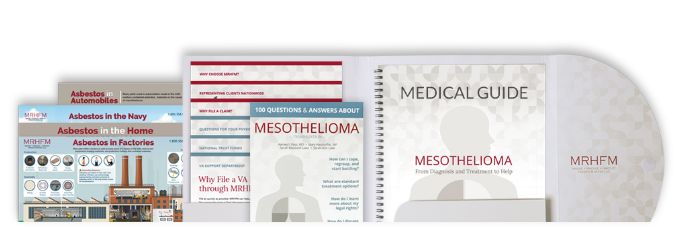What is Pleural Mesothelioma?
Pleural mesothelioma is caused by inhaling asbestos fibers that get lodged into the protective lining of the lungs (the pleura) and cause genetic mutations in the surrounding cells. In some cases, this leads to pleural mesothelioma. Accounting for approximately 75 percent of all mesothelioma cases diagnosed each year, pleural mesothelioma is one the most common type of mesothelioma, which means specialists have more opportunities to develop new treatments for malignant pleural mesothelioma. Pleural mesothelioma occurs in the thin lining that protects the lungs, called the pleura. The primary cause of mesothelioma is exposure to asbestos.
Pleural Mesothelioma Stages
During the diagnosis process, a doctor will determine the stage of pleural mesothelioma by determining how it has spread from where it first appears in the pleura. Based upon the stage, treatment options will be presented: patients with malignant pleural mesothelioma in stage 1 or stage 2 may have more standard treatment options while patients at stage 3 or stage 4 may choose more aggressive or combinations of treatments.
Stage 1 | Pleural Mesothelioma
The mesothelioma cancer is localized in the lining of the lung (the pleura).
Stage 2 | Pleural Mesothelioma
The mesothelioma cancer has spread to the lung itself, part of the diaphragm, and nearby lymph nodes.
Stage 3 | Pleural Mesothelioma
Pleural Mesothelioma - the mesothelioma cancer has spread throughout one side of the chest, into the chest wall, esophagus and more lymph nodes.
Stage 4 | Pleural Mesothelioma
The mesothelioma cancer has spread into both sides of the chest, affecting other organs, the blood, and bone cells.
Pleural Mesothelioma Symptoms
Symptoms of malignant pleural mesothelioma primarily affect the respiratory system, including airways, lungs and breathing muscles. Typically subtle in the early stages of the disease’s development, pleural mesothelioma symptoms can be mistaken for common respiratory conditions or other ailments. Early signs may include a persistent cough or shortness of breath, which are caused by pleural effusion (excess fluids) in the lining of the lungs.

Persistent Coughing

Persistent Chest Pain

Difficulty breathing

Fatigue

Weight Loss

Fever
Speak with a Mesothelioma Patient Advocate and learn more about Pleural Mesothelioma Today!
Get a Free Medical Guide Today
Melvin and Tamlyn, Texas
Actual Client, Ship Builder
Pleural Mesothelioma Treatments
Depends upon the disease stage, the patient’s age, history and health at the time of diagnosis, and other factors, treatment plans for malignant pleural mesothelioma may vary from patient-to-patient. The most common types of treatment are chemotherapy, surgery and radiation therapy. Often, two or more of these treatments may be used together. Removal of fluid buildup in the chest may also be performed to alleviate pain and other symptoms. Some patients also benefit from alternatives treatments, such as gene therapy, photodynamic therapy, or visual or guided imagery.
Extrapleural Pneumonectomy (EPP)
Patients whose mesothelioma hasn’t spread too far may be eligible for surgical treatment. This is the best way to remove large portions of affected tissue.
Pleurectomy with Decortication (P/D)
A less invasive alternative to EPP, P/D consists of two surgical techniques including a Pleurectomy, which removes the protective lining of the lung on which the tumor is growing and a Decortication, which removes visible tumors around and on the diseased lung.
Pleurodesis
A palliative surgery where doctors ease pain and pressure caused by pleural effusions (fluid buildup in the chest between the inner and outer pleural linings that inhibits lung and chest expansion).
Chemotherapy
Doctors may choose to treat pleural mesothelioma with chemotherapy drug, either by itself or combined with other chemotherapy drugs.
Radiation
Doctors may elect to use radiation therapy to shrink pleural mesothelioma tumors, which may be used as a palliative treatment or in combination with chemotherapy and surgery.
Mesothelioma Prognosis
With a pleural mesothelioma diagnosis, patients may have a more favorable prognosis than those patients diagnosed with other types of mesothelioma. Being the most common form of the disease, more doctors have seen and treated it. Cell type and cancer stage of mesothelioma play the biggest role in your prognosis. Your mesothelioma prognosis depends on a number of factors, including: Cancer stage, Cell Type, Age, Overall health (heart, kidneys, etc.).
Mesothelioma Life Expectancy
Once a prognosis has been delivered, it is up to you to take control and make it your mission to extend your life expectancy. While you cannot change your diagnosis, getting help from doctors that specialize in treating malignant pleural mesothelioma can help. Finding new treatments, seeking multiple opinions or combining treatments available may help improve your life expectancy.
Causes of Pleural Mesothelioma
Exposure to asbestos is the primary cause of pleural mesothelioma. Most patients diagnosed with mesothelioma held occupations where they knowingly or unknowingly came in contact asbestos, or used products containing asbestos. In some cases, family members of those who were exposed to asbestos in their work have developed mesothelioma. This may have resulted from asbestos dust being brought into the home on the workers’ clothing. Due to its qualities of heat resistance and fiber strength, asbestos has been used extensively in materials such as insulation, roofing shingles, cement and flooring products, as well as has been used in brake and clutch linings, heat-resistant fabrics, gaskets and coatings.
Exposure
Whether directly working with products containing asbestos or having secondary exposure from those who came into contact with asbestos from their occupation, asbestos is the primary cause of pleural mesothelioma.
Ingestion
Malignant pleural mesothelioma results from breathing microscopic asbestos fibers into the lungs. Once the fibers enter the body, they become lodged in the lungs and the body is unable to eliminate them.
Incubation
Over as many as 10 to 60 years, the irritation from these asbestos fibers entering the body can cause a buildup of scar tissue (asbestosis) and, in some cases, the development of cancer, including pleural mesothelioma.






